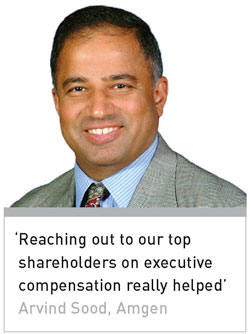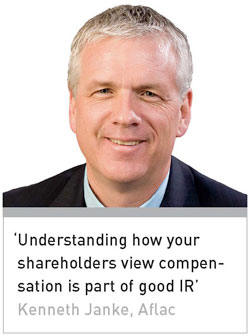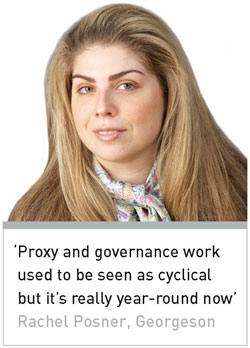|
 
 |
December 2009
Conversation starter
Discussing executive
compensation is a good starting point for shareholder engagement
By Adrienne Baker
|

Conversation starter
-
Say on pay is a good jumping-off point for
engaging shareholders
-
Formats include governance roadshows,
surveys and online forums
-
Many institutions simply following proxy
adviser recommendations
By Adrienne Baker
Say on pay is one of the hot topics for
proxy season 2010 and is widely viewed by companies as a valuable
springboard for engaging major shareholders. ‘You can use a dialogue on say
on pay as an opportunity to convey to shareholders that you are interested
in their feedback and want to have an open-door policy,’ explains Arvind
Sood, vice president of IR at California-based Amgen.
Amgen took the unusual step of asking its shareholders what they thought of
its compensation plan last March through a 10-question online survey.
Working closely with pension fund TIAA-CREF to design the survey, the
company then reached out to its top 30 holders and received a range of
responses. ‘Some said they were pleased our plan is performance-based and
our metrics are clear and easily understood,’ reports Sood. ‘There were also
some concerns. For instance, some were worried about the disparity in
compensation between executives and other employees.’
 The
net effect was positive, with the survey serving to establish an ongoing
dialogue with Amgen’s major holders on several issues, including
compensation. The
net effect was positive, with the survey serving to establish an ongoing
dialogue with Amgen’s major holders on several issues, including
compensation.
Say-on-pay action
Spurred on by impending US legislation on say on pay, as well as increased
pressure from investors on compensation issues, companies are recognizing
the value of engaging their shareholders on the issue of pay. Microsoft
recently announced its triennial non-binding vote on compensation, and
others are expected to follow. ‘More companies are including voluntary
say-on-pay votes,’ comments Rachel Posner, senior managing director and
general counsel at Georgeson.
‘A lot of companies want to get ahead of the pack on required say-on-pay
action,’ adds Arthur Crozier, co-chairman of Innisfree.
The US House of Representatives approved a say-on-pay bill giving
shareholders a non-binding vote on executive compensation last April. The
timing of its passage now depends on how quickly the Senate moves on the
legislation. ‘Most people are expecting say on pay to apply in 2011,’ says
Reid Pearson, managing director of the Altman Group. ‘Labor unions and
pension funds that have been big proponents of say on pay are not going to
go away, however. They will continue to push this year.’
Last year, US corporations receiving Troubled Asset Relief Program funds
were required to include a say-on-pay vote. Management proposals on
compensation plans were overwhelmingly supported among this group, which
fits with the broader trend of voluntary executive compensation votes.
DF King & Co senior vice president Richard Grubaugh points to the fact that
pay proposals are still considered ‘routine’ under NYSE Rule 452, which
governs discretionary broker voting. ‘These votes are given the routine
broker vote, which is why the results are so overwhelmingly in favor,’ he
explains.
Stepping out
As it turns out, the dialogue with shareholders on the sensitive topic of
pay isn’t as awkward as might be expected. In fact, IROs say it’s useful.
Insurance giant Aflac was the first company to voluntarily institute an
advisory vote on executive compensation in 2007. The company received a
shareholder proposal on say on pay and decided to include a voluntary vote
as a way of addressing investor concern.
 Vice
president of IR Kenneth Janke was opposed to the idea early on but soon
recognized the value of engaging with investors on compensation. ‘Our CEO
pointed out that it is really not that unreasonable for people who have
invested their capital or other people’s capital in our company to have a
say in how we pay people,’ he says. ‘We also felt say on pay had gathered
enough momentum to become law, and a lot of companies would face the same
thing.’ Vice
president of IR Kenneth Janke was opposed to the idea early on but soon
recognized the value of engaging with investors on compensation. ‘Our CEO
pointed out that it is really not that unreasonable for people who have
invested their capital or other people’s capital in our company to have a
say in how we pay people,’ he says. ‘We also felt say on pay had gathered
enough momentum to become law, and a lot of companies would face the same
thing.’
Working closely with outside counsel and advisers, Janke made contact with
Aflac’s shareholders to find out how they felt about the company’s
compensation plan. ‘We didn’t have to do much in terms of winning over
investors,’ he reports. For the last two years, shareholders have voted
strongly in favor of Aflac’s advisory vote, with 93 percent support in 2008
and 97 percent in 2009.
Governance experts underline the importance of starting early when launching
say-on-pay discussions. ‘The process should start as soon as possible,’ says
Posner. ‘Proxy and governance work used to be seen as cyclical but it’s
really year-round now.’
Pearson suggests including a question about compensation in IR roadshows.
‘Some of the pay practices are confidential but as long as IR is not
soliciting a vote, the more information you can glean from conversations
with investors, the better,’ he says.
 Critical
to say-on-pay engagement is identifying and gaining access to proxy decision
makers. ‘Most IR departments have good relationships with the portfolio
managers but they are generally not the primary voters,’ explains Ron
Schneider, vice president of business development, proxy solicitation and
meeting services at the Bank of New York Mellon. Proxy voters sit on the
governance or compliance side of most institutions and their contact with
the equity management side varies by institution. Critical
to say-on-pay engagement is identifying and gaining access to proxy decision
makers. ‘Most IR departments have good relationships with the portfolio
managers but they are generally not the primary voters,’ explains Ron
Schneider, vice president of business development, proxy solicitation and
meeting services at the Bank of New York Mellon. Proxy voters sit on the
governance or compliance side of most institutions and their contact with
the equity management side varies by institution.
Some institutional investors also tend to simply vote with management or
according to the recommendations of proxy advisory services like RiskMetrics
Group and Glass Lewis when it comes to pay proposals. For IR, it’s a matter
of identifying the proxy voting pattern or decision maker one institution at
a time. ‘An experienced proxy solicitor can go down the list of institutions
and tell you who is going to make the voting decision,’ adds Crozier.
On the road again
Once IR has identified the proxy decision maker, it’s a matter of finding
out what he or she thinks about the firm’s compensation plan. Some IR
departments are accomplishing this through special governance roadshows
where they meet with proxy voters or proxy committees to discuss various
issues, including pay.
‘This offers a good opportunity to understand their particular interests,
whether they can push for say on pay and what style of say on pay they
want,’ says John Siemann, partner at Laurel Hill Advisory Group.
When Sylvia Groves was chief governance adviser and assistant secretary at
Calgary-based Nexen, she found her company’s annual governance roadshow was
an effective way to understand shareholder views on compensation. ‘Meeting
with shareholders takes some of the risk out of not knowing how our
shareholders are going to respond,’ says Groves, who is now principal of GG
Consulting. ‘Shareholders can completely disagree on compensation issues so
it is important to know your long-term holders and ask them about their pay
concerns as they relate to your company.’
During meetings, it’s a good idea to gather feedback on last year’s proxy
and find out what investors are focusing on in terms of pay plans and their
disclosure. ‘If a company had say on pay last year and the investor didn’t
support it, you might want to ask why – was it the company’s disclosure or
compensation amounts, for instance?’ says Schneider.
Early days
The good news is there is no cookie-cutter approach to say-on-pay engagement
and companies are developing innovative approaches to this type of
shareholder outreach, including online surveys and confidential perception
studies (see New tools, left). The key is to develop a productive dialogue
with institutions and gain useful feedback on compensation.
‘It’s also important to tell your shareholders how your compensation plan
fits with your program for building overall shareholder value,’ says Crozier.
This is particularly significant if a company’s compensation plan diverges
from institutional views or proxy adviser recommendations, he adds.
While it’s clear companies need to understand their shareholder base and
where individual holders sit on pay issues, proxy experts suggest a lot of
work needs to be done on the institutional side, too. ‘The onus is always on
companies to put out more disclosure, but the institutional investors really
need to do something with all that information,’ says Crozier.
Most institutions don’t have the internal resources to analyze numerous
different pay strategies and will likely follow proxy adviser
recommendations. ‘It is very hard for investors owning thousands of stocks
to thoughtfully understand companies’ compensation policies,’ says
Schneider. Therefore, until institutions can properly and easily understand
compensation plan disclosure, it will be a challenge for IR to have
meaningful discussions with all large holders.
Still, IROs who have engaged with shareholders on this topic feel this
dialogue is important to their IR strategy. ‘Knowing your shareholders and
understanding how your shareholders view compensation is part of good IR,’
maintains Janke.
With mounting interest in executive compensation among shareholders, it’s
also useful for IR to find out where a company’s holders sit on this topic.
‘Proactively reaching out to our top shareholders ourselves on executive
compensation really helped,’ concludes Sood. ‘Companies shouldn’t
automatically conclude that the feedback will be negative.
New tools
In addition to one-on-one meetings with proxy decision makers, there are a
number of innovative tools companies are using to get investor input on
executive compensation. For example, Amgen and Prudential are using online
surveys to gather investor comments on their compensation plans.
California-based Intel used an online platform developed by Broadridge
called Shareholder Forum last proxy season to engage shareholders. This tool
allows validated shareholders to submit questions, vote and answer surveys
online. ‘Online surveys can be open to anyone to view but through our
validation process, an issuer understands it is hearing from actual
shareowners,’ says Chuck Callan, senior vice president of regulatory affairs
at Broadridge.
This technology allows companies to develop sampling strategies so the
responses they elicit are representative of major shareholder groups. So far
companies have asked a range of questions on compensation in an effort to
understand shareholders’ views on particular aspects of pay packages.
Confidential perception studies can also be an effective way to gauge
shareholder sentiment on pay, and New York-based DF King & Co is developing
such studies for compensation issues. ‘This is a difficult issue for anyone
to discuss and investors tend to be either too aggressive or too passive,’
says Richard Grubaugh, senior vice president at DF King. ‘We will reach out
directly to institutional investors confidentially to get their perception
of a firm’s compensation policy.’
|




 The
net effect was positive, with the survey serving to establish an ongoing
dialogue with Amgen’s major holders on several issues, including
compensation.
The
net effect was positive, with the survey serving to establish an ongoing
dialogue with Amgen’s major holders on several issues, including
compensation.  Vice
president of IR Kenneth Janke was opposed to the idea early on but soon
recognized the value of engaging with investors on compensation. ‘Our CEO
pointed out that it is really not that unreasonable for people who have
invested their capital or other people’s capital in our company to have a
say in how we pay people,’ he says. ‘We also felt say on pay had gathered
enough momentum to become law, and a lot of companies would face the same
thing.’
Vice
president of IR Kenneth Janke was opposed to the idea early on but soon
recognized the value of engaging with investors on compensation. ‘Our CEO
pointed out that it is really not that unreasonable for people who have
invested their capital or other people’s capital in our company to have a
say in how we pay people,’ he says. ‘We also felt say on pay had gathered
enough momentum to become law, and a lot of companies would face the same
thing.’ Critical
to say-on-pay engagement is identifying and gaining access to proxy decision
makers. ‘Most IR departments have good relationships with the portfolio
managers but they are generally not the primary voters,’ explains Ron
Schneider, vice president of business development, proxy solicitation and
meeting services at the Bank of New York Mellon. Proxy voters sit on the
governance or compliance side of most institutions and their contact with
the equity management side varies by institution.
Critical
to say-on-pay engagement is identifying and gaining access to proxy decision
makers. ‘Most IR departments have good relationships with the portfolio
managers but they are generally not the primary voters,’ explains Ron
Schneider, vice president of business development, proxy solicitation and
meeting services at the Bank of New York Mellon. Proxy voters sit on the
governance or compliance side of most institutions and their contact with
the equity management side varies by institution.